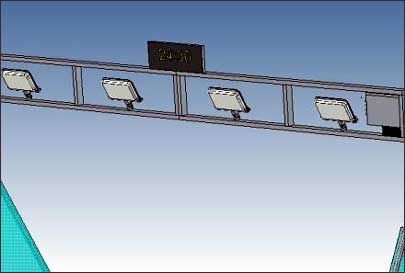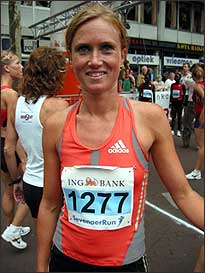Since its founding in 2004, Swedish race organizer Racetimer has sought to differentiate itself from the sports-timing pack, where using low-frequency (LF) RFID tags to track racers’ times is commonplace. Instead, the company has employed passive ultrahigh-frequency (UHF) tags made by Alien Technology (based in Morgan Hill, Calif.) to track runner times. While LF tags are less susceptible than UHF tags to RF interference from liquids—in this case, blood and fluids inside each racer’s body—LF tags also have a very short read range (just a few centimeters), whereas UHF tags can be read from upwards of 60 feet away, according to Alien.
Ronnie Skoeld, Racetimer’s international sales manager, says the company has used Alien’s tags and interrogators since its inception, but after Alien switched to its own EPC Gen 2 chip, the Higgs (or H2), instead of the Impinj chip it initially used, Racetimer began timing large races with many thousands of. Skoeld says the tags containing the H2 chip are not impacted by the high liquid content carried in packs of racers, and that compared with earlier Alien UHF tags, they produce more consistent reads—even when large groups of racers run through read zones simultaneously.
Racetimer creates read zones at a course’s beginning and end, and at split-time zones in between, by suspending a line of antennas above and along the side of the course. An Alien tag is affixed to the top of each racer’s bib, extending at a 90-degree angle from the chest to keep the tag away from the runner’s RF-absorbing body. To pinpoint the exact times at which each racer passes the start and finish lines and each split-time read zone (for example, at the 5K mark on a 10K course), Racetimer utilizes proprietary software that associates the time each tag signal is picked up in a read zone with a break in a laser beam transmitted across that zone.
The break in the beam, detected by a sensor, is caused when a racer’s body passes through the zone and blocks the light. This sensor, Skoeld explains, is similar to the electronic eye mounted at the entrance to many convenience stores that triggers a bell when a customer passes through the door, alerting employees to that person’s arrival.
To date, Racetimer has managed timing only for running races, the largest consisting of 8,000 entrants. However, it is under contract to provide its service to cycling races, triathlons and horse races as well.In addition to timing, Racetimer provides racers access to photos of themselves taken at split times and the finish line. Each runner’s digital photo file names are associated with that person’s tag ID, so that the photos can be displayed at the finish line, sorted by bib number. Racetimer also provides a messaging service enabling racers’ friends and family to stay abreast of their progress on the course. To do this, the company sends a text message to a list of cell phone numbers provided by each racer prior to the race. The message includes the location of the most recent read zone the racer has passed, as well as that entrant’s running time. At the finish area, large digital screens display each runner’s name and finish time, recorded as they cross the finish line.
Race organizers using LF tags generally collect them from racers at the end of each race, Skoeld says, to be reused for other races. Since these tags are embedded in a rugged plastic housing and can cost up to $7 apiece, a race organizer loses revenue when racers fail to return them—though many do, according to Alien’s VP of marketing, Ronny Haraldsvik.

The Alien tags Racetimer utilizes are not reused; rather they remain attached to the race bibs, which most racers keep as mementos. Skoeld says the UHF tags cost Racetimer considerably less than half of what it would pay for LF tags, but declines to offer an exact price. Most UHF inlays embedded in shipping labels used in supply chain applications currently cost roughly 15 cents each in large quantities.
The dominant timing product in large racing circuits is ChampionChip‘s timekeeping system. This system utilizes a passive LF (134.2 kHz) Texas Instruments (TI) tag compliant with the ISO 11784 and 11785 standards, along with interrogator antennas built into mats laid across finish lines and at points along the course where organizers opt to track split times.
Racetimer isn’t the only company competing for a piece of the race-timing industry, however. In March, IPICO Sports entered the market with a dual-frequency passive tag that operates in both the LF and high-frequency (15.56 MHz) ranges. The IPICO tag was used in one of the largest annual U.S. running races, the BoulderBolder (see IPICO Enters Race for RFID Sports Timing.)


